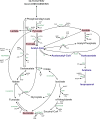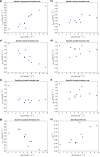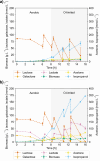Improving sustainable isopropanol production in engineered Escherichia coli W via oxygen limitation
- PMID: 40287719
- PMCID: PMC12032697
- DOI: 10.1186/s12934-025-02720-1
Improving sustainable isopropanol production in engineered Escherichia coli W via oxygen limitation
Abstract
Background: Due to ecological concerns, alternative supply lines for fuel and bulk chemicals such as isopropanol are increasingly pursued. By implementing the formation pathways from natural producers like Clostridium beijerinckii and Clostridium aurantibutyricum, isopropanol can be produced in Escherichia coli. However, developing an industrially and economically feasible microbial production process requires a robust and efficient process strategy. Therefore, this study explores microaerobic conditions in combination with lactose and sour whey as sustainable carbon source as a basis for large-scale microbial isopropanol production.
Results: Different gas-liquid mass transfer regimes (affected by variations of the stirrer speed and ingas oxygen concentration) allowed the implementation of different microaerobic conditions characterized by their specific oxygen uptake rate (qO2) in cultivations with an isopropanol producing E. coli W strain on lactose. Under microaerobic conditions, the specific isopropanol production rate (qp, ipa) exhibited a direct correlation with qO2. Moreover, isopropanol production showed a pseudo growth-coupled behavior. Monitoring of the formation rates of various by-products such as acetone, lactate, acetate, pyruvate, formate and succinate allowed to identify a qO2 of 9.6 mmol g- 1 h- 1 in only slightly microaerobic cultivations as the best conditions for microbial isopropanol production. Additionally, the data suggests that a carbon bottleneck exists at the pyruvate node and the availability of the redox factor NADPH is crucial to shift the product balance from acetone to isopropanol. Finally, confirmation runs prove the effectiveness of the microaerobic production approach by yielding 8.2 g L- 1 (135.8 ± 13.3 mmol L- 1) and 20.6 g L- 1 (342.9 ± 0.4 mmol L- 1) isopropanol on lactose and whey, respectively, reaching a volumetric isopropanol formation rate of up to 2.44 g L- 1 h- 1 (40.6 mmol L- 1 h- 1).
Conclusions: This study identifies slightly microaerobic conditions (qO2 ~ 10 mmol g- 1 h- 1) as the currently best conditions for microbial isopropanol production on lactose and whey in E. coli W. In the future, optimizing the carbon flux around the pyruvate node, ensuring sufficient NADPH supply, and establishing a feedback control loop to control process variables affecting oxygen transfer to the culture, could make microbial isopropanol production feasible at an industrial scale.
Keywords: Escherichia coli; Isopropanol; Lactose; Microaerobic conditions; Oxygen limitation; Sustainable bioprocessing; Whey.
© 2025. The Author(s).
Conflict of interest statement
Declarations. Ethics approval and consent to participate: Not applicable. Consent for publication: Not applicable. Competing interests: The authors declare no competing interests.
Figures






Similar articles
-
Engineering endogenous fermentative routes in ethanologenic Escherichia coli W for bioethanol production from concentrated whey permeate.N Biotechnol. 2020 Jul 25;57:55-66. doi: 10.1016/j.nbt.2020.02.004. Epub 2020 Apr 2. N Biotechnol. 2020. PMID: 32247835
-
Fermentation of lactose to ethanol in cheese whey permeate and concentrated permeate by engineered Escherichia coli.BMC Biotechnol. 2017 Jun 2;17(1):48. doi: 10.1186/s12896-017-0369-y. BMC Biotechnol. 2017. PMID: 28577554 Free PMC article.
-
Microaerobic fermentation alters lactose metabolism in Escherichia coli.Appl Microbiol Biotechnol. 2020 Jul;104(13):5773-5785. doi: 10.1007/s00253-020-10652-6. Epub 2020 May 15. Appl Microbiol Biotechnol. 2020. PMID: 32409946
-
Metabolic engineering of Saccharomyces cerevisiae for lactose/whey fermentation.Bioeng Bugs. 2010 May-Jun;1(3):164-71. doi: 10.4161/bbug.1.3.10619. Epub 2009 Nov 13. Bioeng Bugs. 2010. PMID: 21326922 Free PMC article. Review.
-
Biobutanol from cheese whey.Microb Cell Fact. 2015 Mar 5;14:27. doi: 10.1186/s12934-015-0200-1. Microb Cell Fact. 2015. PMID: 25889728 Free PMC article. Review.
References
-
- Woodley JM. Towards the sustainable production of bulk-chemicals using biotechnology. New Biotechnol. 2020;59:59–64. - PubMed
-
- Panjapakkul W, El-Halwagi MM. Technoeconomic analysis of alternative pathways of isopropanol production. ACS Sustain Chem Eng. 2018;6:10260–72.
-
- Gebel J, Gemein S, Kampf G, Pidot SJ, Buetti N, Exner M. Isopropanol at 60% and at 70% are effective against ‘isopropanol-tolerant’ Enterococcus faecium. J Hosp Infect. 2019;103:e88–91. - PubMed
-
- Li H, Zhao L, Yin S, Chen C, Liu H, Fang J. A novel isopropanol salt aqueous two-phase system and its applications for 2, 3-butanediol extraction. Desalination. 2021;520:115234.
-
- Mahajani SM, Sharma MM, Sridhar T. Direct hydration of propylene in liquid phase and under supercritical conditions in the presence of solid acid catalysts. Chem Eng Sci. 2002;57:4877–82.
MeSH terms
Substances
LinkOut - more resources
Full Text Sources

